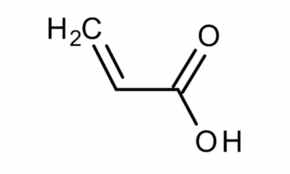HI! I’M ELEMENT AI.
Acrylic Acid

Product Description
Acrylic acid is a simple, unsaturated carboxylic acid with various industrial applications.
Product:
Acrylic Acid
CAS:
79-10-7
Synonym:
2-Propenoic acid; Acroleic Acid; Vinyl Formic Acid
Structure:

Typical Characteristics
Appearance
Colorless Liquid
Boiling point
141 °C
Density
1.05 g/cm3
Flash Point
46 °C
Melting point
13 °C
Molecular Weight
72.06
Odor
Acrid odor
Purity
99.5%
Refractive index
1.4224
Uses, Applications & Markets
Key applications
get a quote
We Offer Acrylic Acid
in various grades
A few of the grades available are listed below:



Acrylic Acid used in many
industry applications
Acrylic acid is a chemical compound with various industrial applications. Here's a list of some of its uses:
- Polymers and Resins: Acrylic acid is a key monomer in the production of acrylic polymers and resins. It polymerizes readily to form polymers with a wide range of properties, including flexibility, transparency, and adhesion. Acrylic polymers find applications in paints, adhesives, coatings, textiles, and construction materials.
- Superabsorbent Polymers: It is used in the production of superabsorbent polymers (SAPs) for use in diapers, feminine hygiene products, agricultural applications, and other absorbent materials. Acrylic acid polymers have the ability to absorb and retain large amounts of water or aqueous solutions.
- Adhesives and Sealants: Acrylic acid and its derivatives are used in the formulation of adhesives and sealants. Acrylic-based adhesives offer strong bonding properties, flexibility, and weather resistance, making them suitable for automotive, construction, and industrial applications.
- Emulsion Polymers: It is used in the production of emulsion polymers for latex paints, coatings, and adhesives. Acrylic emulsions provide excellent film-forming properties, adhesion, and durability, making them suitable for architectural coatings, paper coatings, and textile binders.
- Water Treatment: Acrylic acid polymers are used in water treatment formulations as flocculants, coagulants, and scale inhibitors. They help remove suspended solids, organic matter, and dissolved ions from water, improving clarity, purity, and overall water quality.
- Textile Auxiliaries: Acrylic acid derivatives are used in textile processing as sizing agents, dyeing assistants, and finishing agents. They improve dye uptake, color fastness, and fabric softness in textile materials, as well as provide wrinkle resistance and flame retardancy.
- Personal Care Products: Acrylic acid and its derivatives are used in the formulation of personal care products, including cosmetics, toiletries, and skincare products. They function as thickeners, stabilizers, and film formers in lotions, creams, and hair care products.
- Oil and Gas Industry: Acrylic acid polymers are used in the oil and gas industry for enhanced oil recovery (EOR) operations. They are injected into oil wells to improve the flow of oil, reduce viscosity, and increase oil production rates.
- Plastic Additives: Acrylic acid derivatives, such as acrylic esters and acrylic acid salts, are used as additives in plastic formulations to improve impact resistance, weatherability, and processability. They are used in PVC, polyethylene, and other thermoplastic and thermoset polymers.
- Medical Applications: Acrylic acid-based hydrogels are used in medical applications, such as contact lenses, wound dressings, and drug delivery systems. They provide biocompatibility, hydration, and oxygen permeability, making them suitable for medical and pharmaceutical uses.